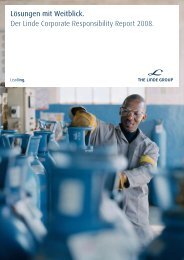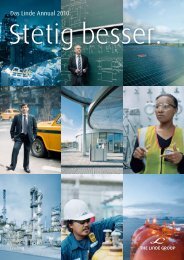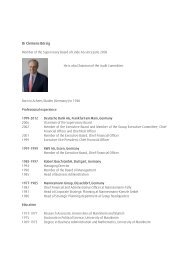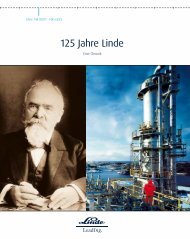The complete history of the development of The - The Linde Group
The complete history of the development of The - The Linde Group
The complete history of the development of The - The Linde Group
You also want an ePaper? Increase the reach of your titles
YUMPU automatically turns print PDFs into web optimized ePapers that Google loves.
AGA – a strong partner for <strong>Linde</strong><br />
Gustav Dalén, an inventor/engineer like Carl von<br />
<strong>Linde</strong>, was president <strong>of</strong> AGA from 1909 to 1937.<br />
As a formerly diversified technology<br />
company with an exceptionally gifted<br />
entrepreneur-engineer at its head, <strong>the</strong><br />
“Aktiebolag Gasaccumulator” company,<br />
or AGA for short, made an ideal partner<br />
for <strong>Linde</strong> AG.<br />
AGA originated in 1904 as “Gasaccumulator<br />
AB” from <strong>the</strong> “Svenska Carbid &<br />
Acetylen AB” company, founded in 1901<br />
by Swedish businessman Axel Nordvall.<br />
<strong>The</strong> young company developed and marketed<br />
possible applications for acetylene<br />
gas. <strong>The</strong> rise to become a leading Swedish<br />
company <strong>of</strong> international significance<br />
was successful even before World War I<br />
thanks to <strong>the</strong> numerous inventions <strong>of</strong><br />
Gustaf Daléns (1869 to 1937), who had<br />
a decisive impact on <strong>the</strong> company beginning<br />
in 1909.<br />
In 1905 Dalén developed a flash device<br />
for lighthouses and buoys that reduced<br />
gas consumption to one tenth <strong>of</strong> <strong>the</strong><br />
original amount. In 1906 <strong>the</strong>re followed<br />
a storage body for acetylene in gas tanks,<br />
which minimized <strong>the</strong> risk <strong>of</strong> explosion.<br />
Dalén’s “sun valve,” introduced in 1907,<br />
regulated <strong>the</strong> intensity <strong>of</strong> light from<br />
lighthouses and buoys depending on <strong>the</strong><br />
level <strong>of</strong> daylight. <strong>The</strong> “Dalén Mixer” <strong>of</strong><br />
1909 finally made it possible to produce<br />
<strong>the</strong> mixture <strong>of</strong> acetylene and air (in a<br />
ratio <strong>of</strong> 1:10), which was necessary for<br />
navigation lights, safely and automatically.<br />
This “AGA System” for lighthouses and<br />
buoys formed <strong>the</strong> basis <strong>of</strong> <strong>the</strong> company’s<br />
economic success. In 1912, Gustaf Dalén<br />
received <strong>the</strong> Nobel Prize in physics for<br />
<strong>the</strong> invention <strong>of</strong> his system. Some <strong>of</strong> his<br />
gas-run lighthouses light <strong>the</strong> way for<br />
ships even today. Although he was blinded<br />
in an accident in 1912, Dalén successfully<br />
led <strong>the</strong> company until his death in 1937.<br />
In <strong>the</strong> period between <strong>the</strong> two world<br />
wars, AGA expanded its product line<br />
with signal systems, welding equipment,<br />
heating elements, radios, large film<br />
projectors and automobiles, which were<br />
manufactured in Berlin. From <strong>the</strong> late<br />
1930s until <strong>the</strong> 1960s, AGA also sold<br />
gyro compasses, gyro-horizons and bomb<br />
target sights for <strong>the</strong> Swedish Air Force.<br />
In 1947 AGA took over <strong>the</strong> battery<br />
manufacturer Tudor. In 1954, AGA introduced<br />
<strong>the</strong> world’s first heart-lung machine;<br />
o<strong>the</strong>r innovative products included <strong>the</strong><br />
distance meter with a geodimeter in<br />
2000<br />
N o 5375 Improved<br />
paper-making process. (AGA European Patent).<br />
At <strong>the</strong> turn <strong>of</strong> <strong>the</strong> millennium, <strong>the</strong>re are more than six billion<br />
people living on earth.<br />
1953 and in 1965 contact-free temperature<br />
measurement with <strong>the</strong> AGA <strong>The</strong>rmovision.<br />
But <strong>the</strong> most important field <strong>of</strong> this<br />
diversified technology company was<br />
technical gases. AGA went from acetylene<br />
to oxygen and soon produced a number<br />
<strong>of</strong> o<strong>the</strong>r gases. As early as <strong>the</strong> 1930s,<br />
AGA became involved in <strong>the</strong> area <strong>of</strong><br />
medical gases. For example, <strong>the</strong> company<br />
supplied oxygen, mainly as a mixed gas<br />
toge<strong>the</strong>r with laughing gas and “Carbogen”<br />
(oxygen with five percent carbon<br />
dioxide) to hospitals for <strong>the</strong> treatment <strong>of</strong><br />
respiratory diseases, for anes<strong>the</strong>sia and<br />
for treatment <strong>of</strong> pain. AGA also built corresponding<br />
technical medical equipment.<br />
With its highly diversified product line,<br />
AGA was unable to withstand international<br />
competition over time. For that reason,<br />
<strong>the</strong> company concentrated exclusively<br />
on its gas business starting in <strong>the</strong> 1980s.<br />
In 1981, AGA already held <strong>the</strong> position<br />
<strong>of</strong> <strong>the</strong> world’s fifth largest gas producer.<br />
Political changes made it possible for<br />
AGA to return to <strong>the</strong> markets in Hungary,<br />
East Germany, Estonia, Latvia, Lithuania,<br />
<strong>the</strong> Czech Republic, Slovakia, Poland, Russia<br />
and Romania after 1989, where <strong>the</strong> company<br />
had been represented before 1945.<br />
In 1999, AGA was an innovative gas<br />
company with a strong market position<br />
in Europe and North and South America<br />
with a sales volume <strong>of</strong> 1.6 billion euro<br />
and 9,500 employees. As far as regional<br />
positioning and product and service lines,<br />
AGA made <strong>the</strong> ideal complement to<br />
<strong>Linde</strong> – <strong>the</strong> main requirements for <strong>the</strong><br />
takeover were <strong>the</strong>re.<br />
After <strong>the</strong> integration <strong>of</strong> AGA, <strong>Linde</strong><br />
Gas and <strong>Linde</strong> Engineering were merged<br />
in 2001 to form <strong>the</strong> <strong>Linde</strong> Gas and<br />
Engineering Division.<br />
In <strong>the</strong> 1980s, AGA concentrated exclusively on<br />
<strong>the</strong> gas business.<br />
81



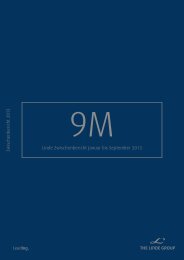
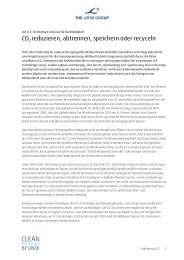

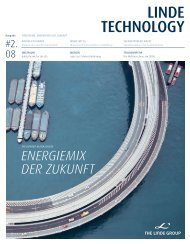
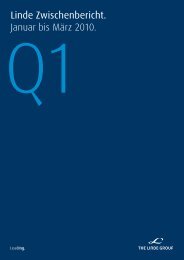
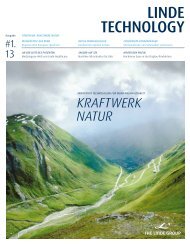
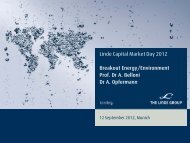
![[41] Anteilsbesitzliste des Linde Konzerns und ... - The Linde Group](https://img.yumpu.com/8356102/1/184x260/41-anteilsbesitzliste-des-linde-konzerns-und-the-linde-group.jpg?quality=85)
![[41] Anteilsbesitzliste des Linde Konzerns und ... - The Linde Group](https://img.yumpu.com/8356076/1/184x260/41-anteilsbesitzliste-des-linde-konzerns-und-the-linde-group.jpg?quality=85)
